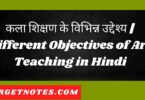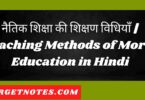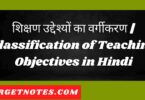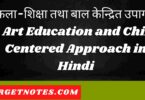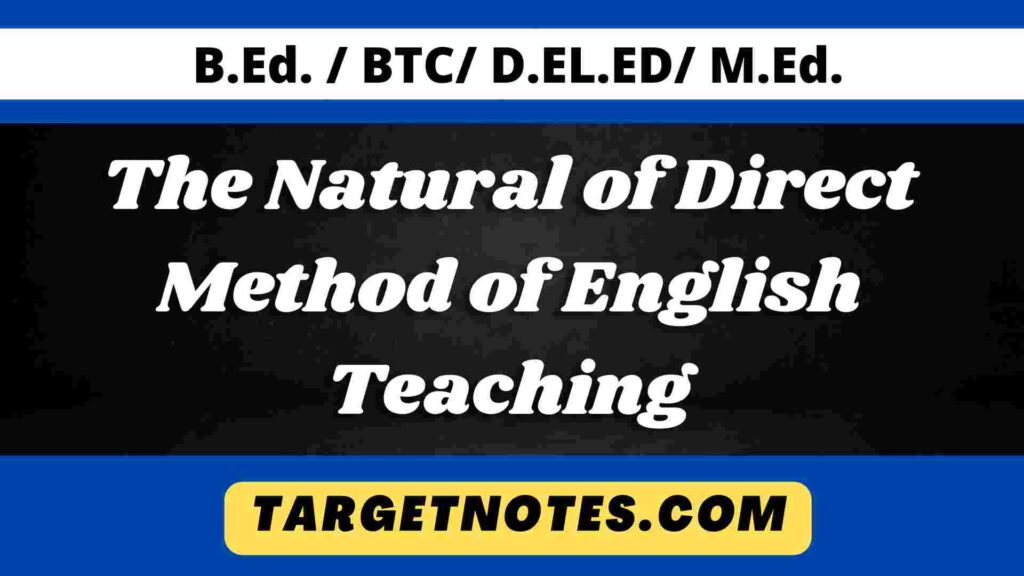
Describe in brief the natural of Direct method of English teaching.
Contents
The Natural of Direct Method
The learning of a language has its main purposes, the purpose of expression, that is, communication of ideas. This includes understanding this point in definition leads to “What is known as the direct method.”
Evolution of the Method- This method was evolved as a reaction to the earlier methods. The main objective of this method was to impart a perfect command of foreign languages. They thought that the pupils should acquire ability to think in the foreign languages and speak them with good pronunciation. This perfection could be achieved by following a natural order.
Therefore, it was called the Natural Method. The suggestion was that the pupil should learn the new speech in the same manner in which he learnt his mother-tongue, “without pre-conceived plan and as occasion demanded.” “It concerned itself mainly with speech and speech material was presented promiscously for memorization. In its extreme form it consisted of a series of monologues by the teacher, interspersed with exchanges of question and answer between the teacher and the pupil, the easier discourses and dialogues being given at the beginning and the more difficult at the end of the course.”
This Method was criticised by Sweet. Sweet agreed with the propositions of this method in relation to the native languages. In the learning of “Our Own Languages”, Sweet writes, “we begin young and we give our whole time to it. Our minds are perfect blanks and we come to it with all our faculties fresh and unworn.” New words of our native language and ideas relating to them are simultaneously learnt. But the case of learning a foreign language, or a second language is entirely different. He writes, “In learning the new language, he has, as it were, to try to unlearn the other language, to struggle continuously against the formidable difficulties caused by cross associations. When sweet tries to pronounce a new sound, his tongue tends to slip back into the position for forming the nearest native sound. So also with word order, grammatical construction generally and the whole fabric of the language.” They have peculiarities of pronunciation, of structures, of grammatical constructions. The native language of the pupils will always pose problems in the study of a foreign language. The process of learning a foreign language will mostly require to ‘unlearn’ the linguistic habits of their mother-tongue, unless transferred judiciously and intelligently.
This method of teaching a foreign language was a sort of reaction against the traditional method: “The Translation, Grammar Method”. It is a more systematic method than the older reform methods it replaced. The Natural method uses the same techniques which the Natural Method presupposes. Its advocates assumed that the opportunities and atmosphere in the case of a foreign language are limited at school in comparison to those of the mother-tongue.
The Direct Method Explained –
The object of the Direct Method is to teach the language directly. It aims to create a direct bond between the word and the meaning, thought and expression i.e., it directly connects a new word or expression of the child with what it stands for. It is an attempt to minimise the use of the mother-tongue. H. Champion is of opinion that instead of using mother-tongue often we should rather employ means which can make them understand the new linguistic material as directly as they can understand the same in their mother-tongue by employing those means. This will require a proper atmosphere. This atmosphere will prevent the use of mother-tongue and stimulate them to think in English. Felix Franke says that the moment a concept and foreign word are intimately brought into contact without the intervention of the native word we have the Direct Method. Hence, the foreign word leads to its concept (meaning).
We can say in more simple words that the emphasis is on enabling the pupils to think in and use foreign languages. Speech rather than reading receives, greater emphasis, i.e., “the emphasis is all on the active side of language learning, and the view is taken that fluency in reading and facility in writing follow fluency in speech.” Kitson rightly says, “Learning to speak a language is always by far the shortest road to learning and to write it.”
P. Gurrey does not regard it a method. Gurrey says that it is a principle. As a principle of language, “it can be used in conjunction with other methods.” Gurrey regards it as “one of the main principles of the Psychology of language that can be directly translated into class-room procedure.” Gurrey further says that it should be applied to all the aspects the teaching of a foreign language-“in the teaching of grammar, new words, new constructions, new sentence patterns. It is applied fully, though often without a teacher realising it “in the lecture explique, in the singing of songs, telling stories and in much dramatic work in the foreign language.”
He is not satisfied with the simple principle of the Direct Method explained above. However, Gurrey does not oppose it. He says, “There is much more in it than that the principle may be explained as the associating of word with thing, of thing with context with expression in the new language. Context may be idea, event, or whole situation; but the fullest application of the method is the associating of a complete thought expressed in words with the real experience that would give the occasion and impulse for the thought.”
The Working of the Direct Method-
In order to understand P. Gurrey, let us consider an example. The word, ‘book’ is to be taught. The teacher will hold a book in his hand and showing upto the class, will say, “you see a book in my hand. This is my book.” Touching the book of a pupil, he will repeat and say, “This is his book.” “I open my book.” “I put my book on the table.” “Put your book on your desk.” He may ask questions on his own actions or on the actions of his pupils. First he must speak. During his speech, the pupils will listen attentively. Gurrey must demonstrate the action. The pupils will follow and the teacher will ensure that their actions correspond to his commands. In this way, the ‘idea’ of a ‘book’ along with the object and actions will be established in their minds. This happens because the word ‘book’ is immediately associated with words expressing the act. It is true that they have seen a book before, they have opened it, seen its pictures, counted its pages, put it in their bags and taken it out of it, but their attention and interest in making sure by looking, touching and doing as the teacher wants them to do, will transform the small events into their full experience. In this way, the word “book’ becomes “part of a large unit of thought and understanding, reinforced by sense perception, interest and enjoyment.” As they have seen their teacher holding a book, “opening it, and have also done all these cations for themselves, their experience of “book” has become ‘real’ to them.” The language which enables them to experience such realities is an essential part of that experience. “It has thus, played upon their minds with the purpose and significance of real language, even though it is so simple. In addition, their interest, attention and pleasure have increased the completeness of their participation in a concrete physical event and thereby have strengthened their learning.” Simple, physical action, which can easily be woven into their full experience by continuing the event will drive home the meanings of the new words and “imprint them on mind and memory….” “If attention has been concentrated and interest fully alive, it will print them indelibly.”
Simple words used in their proper context may not always evoke enough interest and attention at all stages, specially at the middle and the higher stages of learning. The teacher will have to be careful in selecting his material according to their age, requirement and interest. “The degree of completeness will depend on the sophistication and maturity of the children.”
In attaining successful results by the application of Direct method, ‘full contextual situation’ of a living event is needed. “Mary and her Lamb” is a fine poem and the author had the opportunity of demonstrating it before Class VII. With a doll and a model of Lamb, the entire poem was demonstrated to the class, each word in the line, when read and each action when demonstrated appealed to the imagination of the pupils and evoked their interest. This building up of a full situation is the real virtue of this technique. This enable to focus the attention of the pupils on simple dramatic actions, on words and sentences that receive their meanings from them. Their imagination is stirred up as the incident is happening before their eyes and their curiosity is aroused. Curiosity is the backbone of all teaching. If you are successful in arousing the curiosity of your pupils by creating a lively situation, enabling them to participate with interest in what you intend them to learn, half of your battle is won. The incident will itself explain the meaning of the word or words used in language. It is through such situation in which the teacher will speak and demonstrate by action that their minds will concentrate on the incident. Nursery rhymes and action songs are such items in teaching English at the early stage when actions, demonstrations and presentations of objects can be best employed for practising Direct Method. “Therefore the meaning is clear to them, without explanation or translation and it is so bound up with a complex of actions, feeling and language, that the new patterns of words and meanings are firmly impressed on their memories. In brief, the new word in the new sentence that gives it life is associated with a short series of actions and speech in some small incident of real life.” “Therefore, the new language is woven by the shuttle of interest, curiosity and imaginative understanding into the children’s mental life and linguistic habits.” Witness the Dramatic Method. Its chief value lies in carrying out the principles of the Direct Method. The illustration I have given above shows how thoroughly this method should be handled. One should bear in mind two things-one, that the new words “are an integral part of a living incident, arising out of it and second-they have to be worked into the pupils’ own thinking and speaking habits.”
Therefore, the teacher may begin by speaking the names of the things in the class-room and ask his pupils to repeat them. These words, too, may be put into some action and so their association with their meanings may be established. “Open the gate, please”, “Give me chalk”, “Clean your seat”, “Where is it?” “Here is the key”, “Take out the chalk”, “Open the lock”, “Clean the board,” “Give me another”, “This duster is dirty”, “Your shirt is white”, “His shirt is blue”, etc. Simple incidents of dusting, sweeping, tidying of the room, rearranging the class in an order may be invented.” Groups may be formed and each group may be allowed to come in free contact with the other. From such simple incidents, the teacher may proceed to the complex ones. Selection of situation is important. It is according to this situation that the teacher will think of words, sentence-patterns, actions and the other ways of illustrating them. “Therefore, they practise structures and increase their vocabulary by making use of significant and purposeful language. Hence, language is used to find out something that the speaker really wants to know, as it would be used in real life.”
Characteristics of the Method-
We have seen that this Method aims at creating a direct bond between words and ideas and between thought and expression. Language, which can help us to express our ideas has been defined as the “translation to experience.” Thus, in all languages, whether native or foreign, there should be a close relationship between words and thoughts. They should be well-knit together. If it is not so, thinking in that language will not be possible. Therefore, a direct bond between experience and expression should be formed. That is why this Method makes sentence (in contrast to the Translation Method, where the unit is a word) the unit of expression. This direct bond is formed by associating the words of a foreign language with the objects and ideas for which they stand and by minimising the use of the mother-tongue.
It lays emphasis on oral teaching. It recongnises that the roots of direct association lie in the spoken aspect of the language. This requires constant conversation with the students. It will be the first duty of the teacher to help his pupils and assist them when they falter, stumble or stammer. Direct method, in order that the spoken aspect is developed, lays emphasis on the teaching of phonetics “so that the production of foreign speech sounds may be learned systematically according to well-tried methods and not merely by imitation.”
It proceeds from simple living situations to complex ones. Words, phrases and idioms and sentence-patterns suiting to that living situation and the situation in direct relationship with that selected phraseology help in its understanding. It follows the principle of “Proceed from the concrete to the abstract.”
The new phraseology can be acquired by practising it and using it constantly. It will require, if not always, then in the beginning, a definite plan. Palmer says that the teacher must aim at making his pupils “spontaneous memorisers” until they are word perfect. The study of a language, whether we study its words in isolation or in word-groups, is a series of acts of memorising. In order to memorise, “we must articulate, either audibly or mentally.” Louis de Glehn is of opinion that an exact correspondence between thought and expression is linked “with the physical experience of hearing and articulating living speech. All this will require a definite planning. In order to achieve success, we will have to believe Kirkman, “that each lesson should be based upon a definite plan, that there should be a carefully limited amount of material, that this should be taught in orderly stages and be systematically revised.”
The Mother-Tongue-
The use of mother-tongue in the teaching of English by this Method should be reduced to a minimum. Champion says, “To prevent the intervention of the mother-tongue between the English word and its meaning, is to inhibit the mother-tongue”. Champion plays upon the literal meaning of the word. Champion says, “To inhibit means to restrain, hinder.” He gives a psychological background to his meaning of the term ‘inhibit’ and says that the stronger tendency will inhibit the weaker. I have just said that pupils are likely to let go their attention and interest from a dull and lifeless lesson and attend to the gossips which their friends are indulging in or to concentrate upon a passing band announcing the Cinema advertisement. Why does this occur? The band of music according to Champion, has a stronger appeal than the lesson in the class. A reverse may happen in a lively and interesting lesson. Hence, the teacher is to present such “stimulation” as will create desirable tendencies. In this way, stimulation or motivation in modern sense, plays vital role in the application of this Method. In an English lesson, where all possible care is taken to make the lesson lively and interesting, where a proper atmosphere is presented to stimulate its learning and “any unnecessary introduction of the mother-tongue is avoided, there the pupils are likely to develop those “stimulations” which will inhibit the mother-tongue.” According to O. Jesperson, “Translation ought to be used sparingly and at all events, it is not necessary to translate whole connected pieces, but merely a word or, at the very most, a sentence now and then.” The use of mother-tongue is likely to create an obstacle in the process of comprehension which the Direct Method claims to achieve. Its use does not go to create that atmosphere which is required to learn the language. Its influence is unsettling Findley is of opinion that “necessary explanation” may be given by the teacher but thereafter reference to vernacular “allowing it to fall below the threshold of consciousness” should be dropped. Kirkman reviews the principle, “The principle is that a foreign word or word-group should be associated with its meaning directly-in other words, without the habitual intervention of the native speech.”
Inductive Teaching of Grammar-
We have seen that this Method lays emphasis on the oral work-speaking and reading. It means that the pupils should hear and speak without the intervention of the mother-tongue. The pupil has to rely on his ear to learn English. This means that he is relying on a haphazard method of learning the language. In order that he may not make the errors of idiom, word-order, sentence-structure, he must have a knowledge of Grammar. This will enable him to speak the language correctly.
What is the place of grammar in this method and how should it be taught ? As a matter of fact, this Method does not approve the teaching of formal grammar-the memorising of its rules and instances. The method, in its essence, as Kirkman points out, “is a system of acquiring a language by dint of using it. It may in fact, be said frankly to ignore grammar.” “The learning of grammar is not a pre-condition of learning the language. In the Direct Method, learning precedes grammar.”
Yet the Method is grammatical. We mean that the linguistic material, which is to train our pupils in speaking and hearing, is “founded on a scheme of grammar.” Theoretical grammar is for the teacher. The pupils, while acquiring certain language forms by their direct means will be collected and classified and “the rule of grammar is then framed.” “It is his path-finder, his compass and without a good practical knowledge of grammar, he could not draw up a successful lesson.” This means that Kirkman, who professed to ignore grammar, was not wholly correct.
From this statement it is clear that the knowledge of grammar is essential. It is essential to give the pupils a full knowledge of the language they are learning to enable them to use it more effectively.
Grammar should be taught inductively. Grammar is not an end in itself. It is a means to an end. Therefore, practice should precede theory. According to Champion, “The use of language forms precedes the naming and classifying these forms.”
IMPORTANT LINK
- The Natural of Direct Method of English Teaching
- Advantages and Limitation of Direct Method
- New method of English teaching
- Methods of English Teaching | The Translation-cum-Grammar Method | Merits and Demerits of the Method
- General and Particular aims and objectives of English teaching

